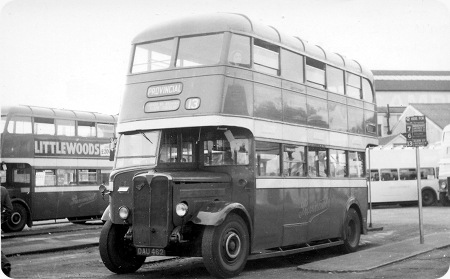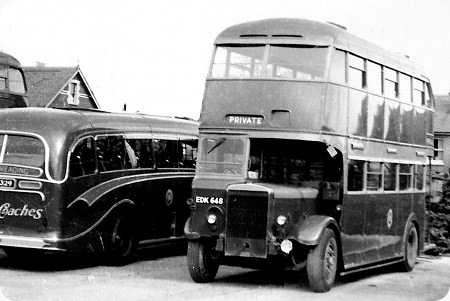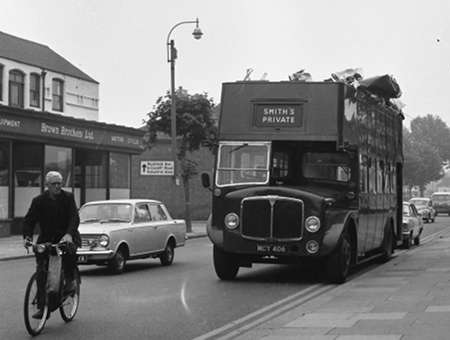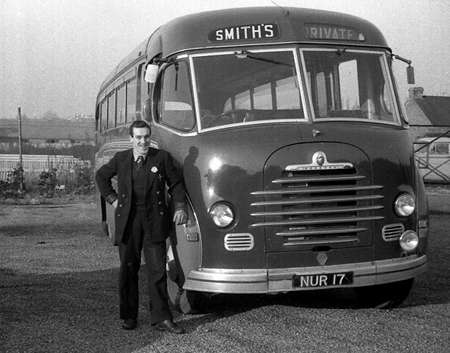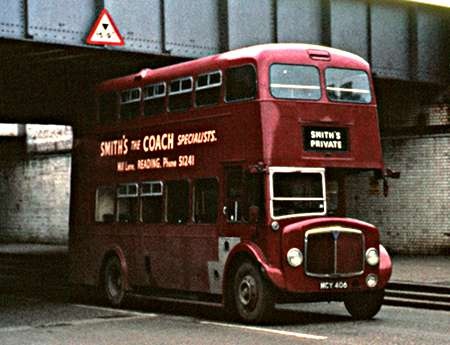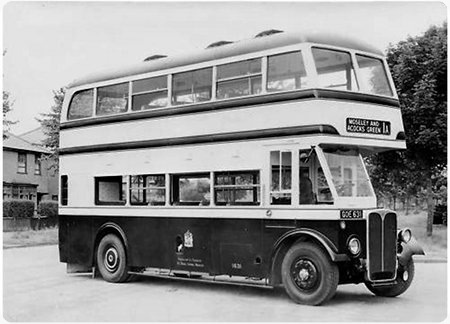
Birmingham City Transport
1947
AEC Regent III RT
Park Royal H54R
Having sent some bus ticket shots to the ‘Old Bus Tickets’ website I was looking at the ‘Old Bus Photo’ section (again) and thought you might like to add a picture of probably my all time favourite bus of my youth. The Birmingham Corporation Transport Park Royal bodied Regent III (RT type) GOE 631 Fleet number 1631. There were only 15 (GOE 631-645) purchased in 1947 and most of them did sterling work until withdrawal in 1963/4. Sadly none were saved for preservation, this is from an original publicity photo I own, and shows the very attractive lines of this vehicle – at its best just after introduction into service.
Photograph and Copy contributed by Nigel Edwards
Why, I wondered, such an old fashioned body design?
It’s not, except for…. that raked back windscreen, the high-level driver’s door, the narrow lower deck windows and that funny mid-band a foot higher than it should be..then there’s those wobbly-looking front wheels and the lop-sided headlamps: If the "dipped" one is on the left, why is it higher than the right one? No doubt that’s how we always did it…
Joe
It’s not so much an old-fashioned design as the lack of "joined up thinking".
The standard London Transport RT was designed as a whole vehicle but when provincial bodies were fitted, what was standard in the provinces didn’t properly marry with a chassis not generally available outside London and, indeed, designed specifically for London.
For the most part, the Birmingham body would not look out of place on a provincial Regent III – and would have looked more modern than the standard Birmingham body on more usual Crossley, Daimler or Guy chassis which originated pre WW II.
David Oldfield
08/03/11 – 15:22
I have to admit that until now it had not occurred to me that these 15 vehicles looked ‘wrong’. Certainly they looked seriously different to the rest of Birmingham’s post-war fleet but to me they were all the more likeable because of it! One possible reason for the odd looking front-end is that at the time Birmingham were very much into the idea of sloping windscreens to reduce internal reflection (an idea much favoured by Midland Red at the time) – although I don’t quite see the truth of that in a half-cab vehicle with the blinds lowered behind the driver at night.
It is worth noting that when Park Royal supplied a further 50 bodies, this time on Leyland PD2/1 chassis (2181-2230, JOJ 181-230), the raked windscreen was gone and the result was a joy to behold. They looked right!
5055HA
26/08/11 – 07:08
The correct title of the undertaking, was Birmingham City Transport, I remember these buses well, on short workings of route 11 the Outer Circle, between the Fox and Goose at Ward End and the Bull at Stechford on the way to school. These buses I believe were originally ordered for delivery in 1941/2 but received after the war ended.
I disagree with David Oldfield, these buses always looked dated compared to the rest of the post war fleet especially the new look ones. These buses were built to BCT specifications, the other Park Royal bodied buses, Leyland PD2s with flat screens were bought off the shelf to the body builders standard specs! These were magnificent vehicles. One survives fleet number 2222 (JOJ 222) and is currently being restored at the Aston Manor Transport Museum in Birmingham.
The Regents spent virtually all their lives at Acocks Green garage, and were non-standard with air brakes, air gear changes and wind up windows plus other unusual features. I believe 3 of the batch worked out of Barford Street depot early on in their lives on route 8 the Inner Circle.
Like all BCT buses these were kept spotlessly clean and excellently maintained, never a dented panel in sight, shame the operators of today do not value their buses so highly!
This is a great site and I will send some photos of that other great operator from my childhood in Birmingham – Midland Red.
Robert Hayles
26/08/11 – 18:07
It might be the LATE Aston Manor Transport Museum, since it has just closed after an interminable wrangle over high rent for the buildings and an exorbitant price the council have quoted for the purchase of it.
Let’s hope the matter can be resolved. Were the museum to continue with the rental option, it would have to charge £8 a time for entry! If it’s not resolved, they have to be out by end-December.
Chris Hebbron
03/12/11 – 07:05
1631-1645 were very different from the standard Birmingham bus and were reputably bought as replacements for AEC Regents that were going to be ordered, but never were for delivery in 1941. RT 19 was demonstrated to BCT between 7/6/41 and 7/7/41 and these RTs were the result. They spent their lives at Acocks Green garage, although the last four were allocated to Barford Street in 1948 for a rather unsuccessful stint on the busy Inner Circle route. The bodies were more or less the standard four-bay Park Royal thin pillared body of the time but were heavily modified with BCT fixtures and fittings. The RT chassis had air-brakes which BCT engineers did not like and the braking standards on the batch were always dubious. This resulted in the buses having a wide range of brake modifications including being fitted with disc brakes. They were lovely to ride-in but a lot of Acocks Green drivers did not like them because of their poor stopping performance. By the time they were taken out of service, no two of the fifteen buses were the same with experiments with exhauster brakes, sealed radiators, Monocontrol gearboxes and straight through exhaust pipes. They were used on the 44 and 31 and 32 routes, but were only used on short workings on the Outer Circle 11 route as i, they had none-standard staircases which were not considered safe for passengers not already used to them and ii, if drivers had to be relieved by one from another garage which worked on the 11 route, the chances were that they were not passed to drive the RTs! Curiously enough the last one to be withdrawn, 1641, was the only postwar bus to be withdrawn by BCT on Leap Year Day, in this case in 1964.
David Harvey
03/12/11 – 14:31
Thx, David, for that fascinating background information. The braking shortcomings are intriguing, since London traffic conditions was equally as challenging as Birmingham’s, if not more. I wonder if the bodies were heavier than London Transport’s 7.5 tons. Although the 8′ wide RTW’s were heavier, I am not aware that their brakes were beefed up! A mystery indeed.
Chris Hebbron
03/12/11 – 16:40
Strange – I am sure I read somewhere that contemporary Daimlers, of which Birmingham had many, were notoriously weak in the braking department. On the other hand, AEC Regent IIIs (whether RT or the provincial type) seemed to find very wide acceptance throughout the land. Many municipal operators went back again and again for repeat orders. To a mere user, they always seemed utterly competent.
Stephen Ford
04/12/11 – 07:42
Birmingham’s Guys were the ones which suffered from brake fade especially on the Bristol Road routes operated by Selly Oak. It was for this reason that eventually all new look front buses had their front wings shortened. The buses with the best brakes were Crossleys, but these could have very heavy steering if it wasn’t greased properly. The braking on Daimler CVG6 et al were considered to be good, though the exposed radiator ones always seemed to be sharper on the brakes that the new look front ones. We thought at the time that it was just a more sophisticated system!
The AEC Regent 0961 RTs weighed 7 tons 16 cwt but brakes were always a problem.
David Harvey
30/03/12 – 07:11
Re Birmingham RTs – A friend who drove them says that the brakes were fine. Early on they had a problem with RP automatic adjusters causing the brakes to stick on but the problem was solved with a slight adjustment to brake shoe clearances. A similar problem cropped up with the Halifax examples but apparently St Helens reported no problems.
Alan Bond
13/06/12 – 17:02
When I worked in Birmingham from 1961 to 1963, I lodged at Hall Green. These were my favourite buses at the time, especially when 1632, or 1643 with its lovely roaring sound, were on the last 32 departure from town in the evening. They were very comfortable, and had an excellent turn of speed on the uphill stretches. Such a pity that none survive, or that a model is not available. The model of 1632 which has been produced is a travesty!
Harold Blythe
05/07/12 – 17:49
They were always my favourites too, and I often travelled on them on the No 1 route. When I was little, I especially liked the front downstairs passenger window, because it was lower than on all the other buses, so I could see out straight ahead over the bonnet.
Richard
28/01/13 – 13:31
As a schoolboy in 1957 I remember asking why these ungainly, gaunt, older looking buses were only on the (short) 1A route to Acocks Green and I was told that they had small fuel tanks. Maybe just a jarn to shut me up.
David Grove
29/01/13 – 15:22
David, These ‘RT’ types were "confined" to Acocks Green Garage because only their drivers were ‘passed-out’ to drive them. They were occasionally to be seen on the Outer Circle 11 route but usually only on ‘Service Extra’ at busy times and short turns that did not require driver changeovers from other garages.
Nigel Edwards
31/01/13 – 06:07
I think I have only ever seen one of these in service so I can’t comments on their ride ect but I do find it odd that they had brake problems since they were air braked. At this time BCT and BMMO for that matter had a fixation with reflections in wind screens and both operators had sloping windows fitted which in the case of BCT tended to make their buses look older than they were, the exception being the "tin fronts" which had a sloping screen but inset into the body and having vertical screen pillars. Whilst on the subject of Daimler CV brakes I am currently involved with the restoration of GEA 174, an ex West Bromwich Daimler based at and owned by the Black Country Living Museum, some of our group members have made several references to West Bromwich having problems with the brakes on these when they were new yet another contributor rightly points out that BCT had problems with their Guys in the braking department but not with their Daimlers, odd don’t you think?
William Parker
21/07/13 – 14:55
I worked out of Acocks Green Garage as a bus driver from 1959 till 1978 and drove these Buses many times. They were quicker BUT with Air brakes were much harder to stop. I remember driving down Olton Boulevard West and Trying to stop before turning into Gospel Lane but finished up by Warwick Road 100 Yards further on. I was young and impulsive in those days.
Maurice (MOSS) Leather
10/03/15 – 16:35
I remember these buses as I was an apprentice engineer with BCT from 1950 to 1956 and a fitter in 1957-1960 after doing service in the RAF National service. When I was doing my training on the engine bench I remember building an AEC 9.6 diesel engine and I was really impressed by all the running gear, it was a well built in line diesel engine. In 1959 I remember a problem with the chassis on one bus as it had to have a special plate welded either side which I made up for the job and it was inspected by the works Superintendent Mr Fred Keyes.
Reg Humpage
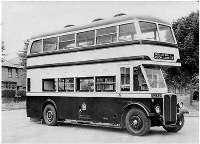 Vehicle reminder shot for this posting
Vehicle reminder shot for this posting
25/12/15 – 08:08
Apparently, the fifteen "Regents" were BCTs only postwar double-deckers to have their bodies lifted. This was to replace AEC chassis bolts with the standard BCT style!!!
David Harvey
